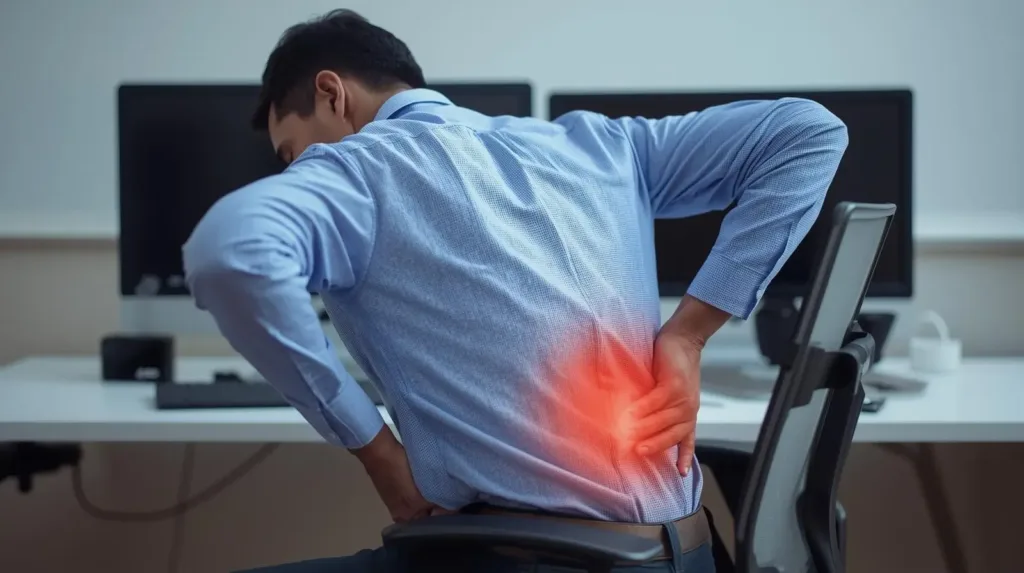You stand up after a long Zoom meeting and feel a twinge grab your lower back. At first, you brush it off. But the ache lingers, sometimes sharp, sometimes stiff, and occasionally shooting down your leg. If you’ve ever wondered whether these are just “normal aches” or signs of something more, you’re not alone.
Low back pain affects nearly 4 out of 5 adults in the US at some point in their life, according to the CDC’s 2025 update. The tricky part is that low back pain symptoms vary from person to person. For some, it’s a dull ache after long sitting. For others, it’s sharp pain that wakes them at night or tingling in the legs.
This guide breaks down the 10 most common low back pain symptoms doctors want you to know—from everyday stiffness to red flags that require immediate care.

Table of Contents
Understanding Low Back Pain Symptoms
When doctors talk about “symptoms,” they mean more than just pain. Symptoms include any sensations, changes, or warning signs related to your lower back. They can range from mild muscle soreness to severe nerve problems.
Why symptoms vary:
- Age: A 25-year-old athlete and a 65-year-old with arthritis may feel back pain very differently.
- Cause: A simple muscle strain causes different symptoms than a herniated disc.
- Lifestyle: Sitting too long, poor sleep, and stress can intensify how pain shows up.
Tracking your symptoms—their pattern, triggers, and relief—helps your doctor understand what’s really happening.
10 Most Common Low Back Pain Symptoms
1. Dull, Aching Pain in the Lower Back
This is the most classic of all low back pain symptoms. It often feels like a constant, heavy soreness in the muscles or joints.
- Common causes: muscle fatigue, poor posture, arthritis.
- When to worry: if the ache lasts more than a few weeks or interrupts daily life.
2. Sharp or Stabbing Pain
Instead of an ache, some people feel a sudden knife-like jolt in the lower back.
- Causes: disc problems, facet joint irritation, sudden awkward movements.
- Warning sign: if sharp pain is linked to a fall or persists beyond rest.
3. Stiffness and Reduced Range of Motion
If you struggle to bend, twist, or stand tall, stiffness may be the culprit.
- Morning stiffness is common with arthritis.
- Postural stiffness happens after long desk hours.
- Worry if: stiffness doesn’t improve with gentle movement.
4. Radiating Pain Down the Leg (Sciatica)
One of the hallmark nerve-related low back pain symptoms is sciatica.
- Feels like: burning, electric, or shooting pain down one leg.
- Cause: herniated disc pressing on the sciatic nerve.
- Red flag: if the pain is severe, constant, or worsens at night.
5. Numbness or Tingling in Legs or Feet
Pins and needles aren’t just annoying—they signal nerve involvement.
- Causes: disc herniation, spinal stenosis, nerve compression.
- Urgent if: numbness spreads or includes loss of sensation in the groin area.
6. Muscle Spasms in the Lower Back
Spasms feel like tight knots or sudden seizing of muscles.
- Causes: overexertion, dehydration, fatigue.
- Good to know: while painful, most spasms ease with rest and hydration.
7. Pain that Worsens with Sitting or Standing
Some people notice pain that flares after sitting too long or standing still.
- Why: static positions increase load on discs and joints.
- Clue: disc problems worsen with sitting; stenosis often worsens with standing.
8. Pain that Improves with Movement

Strangely, many back issues feel better once you start moving.
- Reason: movement lubricates joints, relaxes muscles, and reduces stiffness.
- Contrast: pain that worsens with activity could signal structural damage.
9. Pain Radiating into the Buttocks or Hips
Not all low back pain symptoms stay in the spine.
- Referral: sacroiliac (SI) joint or muscle trigger points can spread pain.
- Important: hip arthritis can mimic back pain—doctors often check both areas.
10. Red Flag Symptoms (Seek Immediate Care)
Some symptoms signal urgent conditions:
- Loss of bladder or bowel control.
- Severe or sudden leg weakness.
- Unexplained weight loss, fever, or night sweats with back pain.
These could indicate cauda equina syndrome, infection, or cancer, and require emergency evaluation.
When to See a Doctor for Low Back Pain Symptoms
- Time frame: pain lasting longer than 6 weeks.
- Severity: if pain disrupts sleep, walking, or work.
- Red flags: any sudden neurological changes.
Causes Behind Low Back Pain Symptoms
- Mechanical: muscle strain, disc herniation, facet joint irritation.
- Age-related: arthritis, spinal stenosis, osteoporosis.
- Lifestyle: sedentary habits, obesity, stress, poor sleep.
How Doctors Diagnose Low Back Pain Symptoms
- History: onset, pattern, lifestyle triggers.
- Physical exam: strength, reflexes, mobility.
- Imaging: MRI for discs/nerve roots, X-ray for bone issues, CT if detailed anatomy needed.
- Lab tests: if infection or systemic illness suspected.
Managing and Preventing Low Back Pain Symptoms
Self-Care at Home
- Stay active with walking and light stretching.
- Use heat for stiffness, ice for acute strain.
- Over-the-counter NSAIDs for short-term relief.
Physical Therapy
- Builds strength in core and glutes.
- Restores mobility and posture control.
- Prevents flare-ups through targeted programs.
Lifestyle Fixes
- Ergonomic chairs and standing desk breaks.
- Maintain healthy weight.
- Prioritize good sleep and stress management.
(For trusted resources, see CDC Back Pain Facts or NIH Low Back Pain Research).
Frequently Asked Questions
What are the first signs of low back pain?
A dull ache or stiffness in the lower back, often after sitting or lifting.
Can low back pain symptoms feel like hip pain?
Yes, pain can radiate into the hips or buttocks, making it tricky to pinpoint.
When should I go to the ER for low back pain?
If you lose bladder/bowel control, have sudden leg weakness, or severe night pain.
Do low back pain symptoms differ in young vs older adults?
Yes—young adults often have disc injuries, while older adults face arthritis and stenosis.
Can stress cause low back pain symptoms?
Absolutely. Stress tightens muscles and worsens pain perception.
How do doctors check low back pain symptoms?
Through history, exam, and sometimes imaging like MRI or X-ray.
Are numbness and tingling always serious?
Not always, but they often point to nerve compression and should be evaluated.
Do low back pain symptoms improve with exercise?
Yes, gentle walking, stretching, and strengthening usually help.
Can low back pain symptoms mimic kidney problems?
Yes—kidney stones or infections can cause back pain, but usually with other signs like fever or urinary changes.
How long should I wait before seeing a doctor?
If pain lasts more than 6 weeks, worsens, or includes red flags, see a doctor sooner.
Conclusion
Low back pain symptoms are one of the most common health complaints in the US. For many, it’s a dull ache that comes and goes. For others, it’s sharp pain, stiffness, or even nerve symptoms like tingling. Most cases are mechanical and manageable with movement, therapy, and lifestyle changes. But knowing the 10 most common symptoms—and especially the red flags—helps you act early, recover faster, and avoid complications.
Suggested Reading
- Doctor Explains What Causes Lower Back Pain and How to Prevent and Reset It
- What Causes Lower Back Pain in Females? From Hormones to Heels, Here’s the Real Story

Dr. Vivek Arora (BPT, MPT, FRCPT, MIAP) is a licensed physiotherapist with over 20 years of experience in spine and joint care. He specializes in evidence-based physiotherapy, patient education, and long-term recovery without surgery. Passionate about empowering patients through knowledge, Dr. Arora shares expert-backed health content for a global audience.
To know more about Dr. Vivek’s journey, click here.
